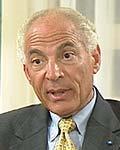 Farouk
El-Baz is an Egyptian-born scientist who worked with
NASA training astronauts in lunar observations.
Farouk
El-Baz is an Egyptian-born scientist who worked with
NASA training astronauts in lunar observations.
 Farouk
El-Baz is an Egyptian-born scientist who worked with
NASA training astronauts in lunar observations.
Farouk
El-Baz is an Egyptian-born scientist who worked with
NASA training astronauts in lunar observations.
Currently, Dr. Farouk El-Baz is Research Professor and Director of the Center for Remote Sensing at Boston University, Boston MA, U.S.A. He is Adjunct Professor of Geology at the Faculty of Science, Ain Shams University, Cairo, Egypt. He is also a Member of the Board of Trustees of the Geological Society of America Foundation, Boulder Colorado.
He was born on January 1, 1938 in the Nile Delta town of Zagazig. At the age of 20, he received a BSc. in Chemistry and Geology from Ain Shams University. In 1961, he received a M.S. degree in Geology from the Missouri School of Mines and Metallurgy (now University of Missouri-Rolla). In 1964 he received a PhD in Geology from the University of Missouri-Rolla after conducting research in 1962-1963 at the Massachusetts Institute of Technology (MIT), Cambridge MA. In 1989, he received an Honorary Doctorate of Science degree from the New England College, New Hampshire and an Honorary Doctorate of Engineering degree from University of Missouri-Rolla.
Dr. El-Baz taught Geology at Assiut University, Egypt (1958-1960) and the University of Heidelberg, West Germany (1964-1965). He joined the Pan American - U.A.R. Oil Company in 1966, where he participated in the discovery of El-Morgan, the first offshore oil field in the Gulf of Suez.
From 1967 to 1972, Dr. El-Baz participated in the Apollo Program as Supervisor of Lunar Science Planning at Bellcomm Inc., (a division of AT&T that conducted systems analysis for NASA). During this time, he was secretary of the Landing Site Selection Committee for the Apollo lunar landing missions, Principal Investigator of Visual Observations and Photography, and chairman of the Astronaut Training Group. His outstanding teaching abilities were confirmed by the Apollo astronauts. While orbiting the Moon for the first time during Apollo 15, Command Module pilot Alfred Worden said, "After the King's [Farouk's nickname] training, I feel like I've been here before."
Also during the Apollo program, Dr. El-Baz joined NASA officials in briefing members of the press on the results of the lunar missions. His ability to use easily understood words made his remarks on the program's scientific accomplishments often quoted by the media.
After the Apollo Program ended in 1972, Dr. El-Baz joined the Smithsonian Institution in Washington DC to establish and direct the Center for Earth and Planetary Studies at the National Air and Space Museum. At the same time, he was elected as a member of the Lunar Nomenclature Task Group of the International Astronomical Union. In this capacity, he continues to participate in naming features of the Moon as revealed by lunar photographic missions. In 1973, NASA selected him as Principal Investigator of the Earth Observations and Photography Experiment on the Apollo-Soyuz Test Project (ASTP), the first joint American-Soviet space mission of July 1975. Emphasis was placed on photographing arid environments, particularly the Great Sahara of North Africa and the Arabian Peninsula, in addition to other features of the Earth and its oceans. Emphasizing the study of the origin and evolution of arid landscapes, he collected field data during visits to every major desert in the world. One of his significant journeys took place soon after the United States and China had normalized relations in 1979, when he coordinated the first visit by American scientists to deserts in northwestern China. The six-week journey was chronicled in National Geographic and the Explorers Journal. His research on the origin and evolution of the desert resulted in his election as a Fellow of the American Association for the Advancement of Science (AAAS). Dr. el Baz was elected a Fellow of the Geological Society of America, the Third World Academy of Sciences in 1985, and to the National Academy of Engineering (USA) in 2002. The Geological Society of America awards annually the "Farouk El-Baz Award for Desert Research," to encourage excellence in arid land studies. In 2006, El-Baz in conjunction with Eman Ghoneim discovered the Kebira Crater, located in the Western Desert of Egypt at the border with Libya. The crater is approximately 19 miles (31 kilometers) wide, more than twice as big as the next largest Saharan crater known.
He is married, has four daughters, and four grandchildren.